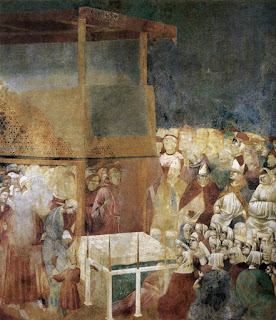4/30/21
 |
| Duccio, "Madonna of Crevole" |
Summarizing Chapter IV on Holy Communion:
Catechetical emphasis is to be given in a thoroughgoing manner. The many details in this section, whether it’s preparing with a good confession, or using the communion plate, or restricting access to both kinds all require a thoroughgoing catechesis rooted in the reality of the MBS, the Real Presence, concomitance, the forgiveness of sins, creation, the Paschal Mystery, the Incarnation and the Most Blessed Trinity. Christians who have weak appreciations of these basic mysteries of our faith are going to find it hard to make sense of why we’re so insistent on communion plates and limiting access to both kinds. There is a direct connection.
Chapter V of RS is called, “Certain Other Matters Concerning the Eucharist”
The four sub-headings within this chapter deal with: Place, Various Circumstances, Vessels and Vesture.
When priests go on vacation the question of where they will celebrate Mass frequently comes up. Aside from the jurisdictional matter of the requirements for letters of good standing there is the practical consideration of the accessibility of a fitting and decent place. “The Dignity and Duties of a Vacationing Priest” is possibly the matter of a separate article altogether. What preference should he have for access to a nearby church? Are hotel rooms always sufficiently decent places for Mass? Can he reserve the MBS after mass for his own private adoration?
Perhaps we will treat some of these in their place within this study. The hope of this study, again, is to make the priest thoroughly acquainted with the mind of the Church concerning protecting the MBS from profanation, careful handling and reservation of the MBS and its appropriate veneration. When this is well understood, it will be easier to develop a useful “Spirituality of a Vacationing Priest.”














